A Yoga Sequence for an Open Heart
This article originally appeared on Yoga Journal
When I get to pick the movie for mother-daughter movie night, I'll suggest a heist movie every time. I love watching a group of clever con artists develop a twisty, sophisticated plot to dupe some semi-villainous mogul out of a rare jewel or a priceless painting. Yes, these are, technically, thieves and they are, in fact, stealing. So perhaps they're not the role models I want for my kid. But she knows I don't condone stealing in real life.
When it comes to the yogic principle of asteya, or non-stealing, we feel comfortable that we aren't breaking-and-entering or robbing banks. (I couldn't pull off a heist if you paid me.) But when we think of the third yama more deeply, we may find we have some work to do.
Why do people steal?
Research shows that people don't always take things because of need. The impulse to take something that isn't ours often comes from a deep emotional place. It may come from a sense of lack or the need to fill a gap inside.
We may be trying to remedy the feeling that we don't have enough. When we are confronted daily with social media documentation of our friends’ good fortune--the sparkling engagement ring, the shiny new car, the luxurious vacation, even the fancy brunch you missed--we can start to feel like we're missing out. If the feeling is intense enough it can make us desperate to have the things we envy in others.
Our insecurities can also make us feel like we aren't good enough. That's where we may be tempted to take someone's ideas as our own--plagiarizing someone else's academic, professional, or creative work.
While the simple translation of asteya is non-stealing, this yama also addresses the cultivation of gratitude and generosity. And it overlaps with ahimsa if taking something causes harm to another person, or with aparigraha, when taking things turns into hoarding behavior.
More than taking what's not yours
Psychiatry professor Robert Tyminkski, author of The Psychology of Theft and Loss, suggests that "the crime of theft is something we are accustomed to and take for granted, seeing it as part of the human condition." This isn’t simply a cynical opinion that people are generally immoral. It is acknowledgment that, in fact, “taking” happens in many contexts. There are times when taking something that isn't yours is necessary and even virtuous. Who would blame a parent for stealing to feed a starving child?
Legend has it that the 17th-century Punjabi emperor Ranjit Singh forgave a hungry woman for trying to steal mangos from his tree, and ordered his guards to give her money for food. She was held blameless for her desperate act, and his forgiveness earned him the reputation for being a fair, noble, and generous leader.
The emperor's act of generosity was asteya amplified. How better to counter an impulse to take than by being openhearted and giving? And how better to support the practice of this yama than with an openhearted asana practice. Try this sequence when you want to feel expansive and generous.
For a more in-depth perspective on asteya, read “Asteya: Knowing When Enough is Enough” by Susanna Barkataki.
Open-Heart Practice
Begin your practice standing in Tadasana (Mountain Pose) at the top of your mat. Find a little movement in your body, perhaps moving slightly forward to back and side to side, feeling your weight shifting in your feet. Alternate bending your knees slightly. Circle your shoulders forward, up, back, and down a few times, noticing and releasing any tension. When you are ready, come to stillness with your hands by your sides and your weight distributed evenly between your feet.
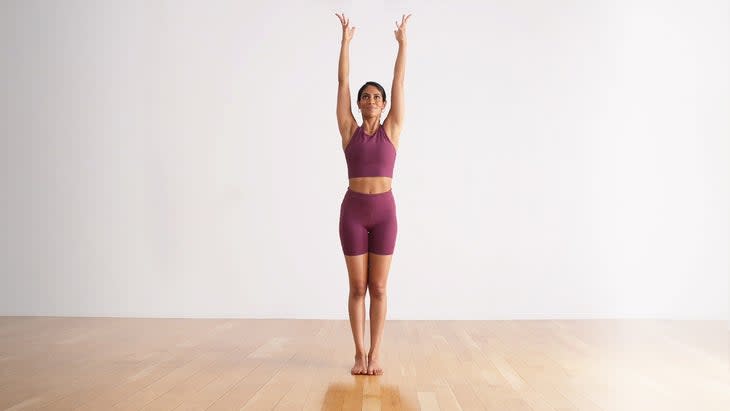
Urdhva Hastasana (Upward Salute)
Come to standing with your weight evenly distributed between your feet in this pose that is also known as Tall Mountain or Palm Tree. Stack the crown of your head above your pelvis, and draw your shoulders back and down away from your ears, but keep your front ribs soft. Notice the gentle opening of your chest. On an inhalation, raise your arms overhead with your hands shoulder distance or a little farther apart and your palms facing each other. Align your arms with your ears and rotate your biceps back and allow your shoulder blades to move up and out away from your spine. Take several breaths in the posture, paying attention to the space it creates in your chest, then release your arms down by your sides. Repeat for a few more times, inhaling to reach up and exhaling bring your hands down.
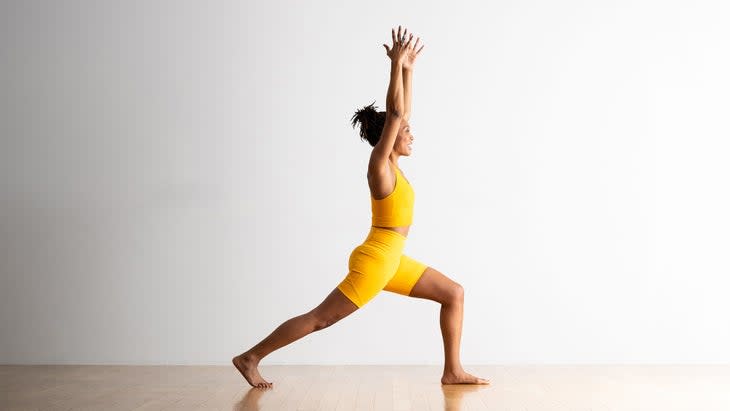
High Lunge
From Tadasana, slightly bend your knees and, with an inhalation, step your left foot straight back 3-4 feet and bring the ball of your foot to the floor. Bend your right knee deeply to bring your thigh parallel to the floor. Step left foot back further if you need to; straighten your back leg as much as you can. Sweep your arms out wide and up overhead, palms facing. Lift your chin to look up forward or toward your thumbs. Bring the shoulder blades deeper into your back to help support the opening of your chest. Hold for 3-5 breaths.

Virabhadrasana II (Warrior 2 Pose)
Pivot on the ball of your left foot and bring your heel to the ground, as you turn your torso to face the long side of your mat. Keeping a deep bend in your right knee. Bring your arms down and stretch then straight out from your shoulders in a T-position. Reach strongly toward the front and back of the mat and turn your head to look past your right fingertips. Stay here for 3-5 breaths.
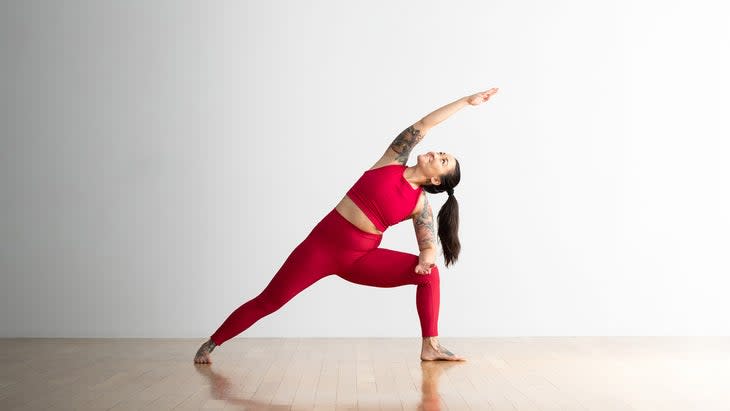
Utthita Parsvakonasana (Extended Side-Angle Pose)
From Warrior II, lift through your spine to keep the sides of your torso equally long, then lean toward your right knee, hinging at the hips. Bring your right arm toward the floor or rest your elbow on your right thigh. Reach your left arm straight up or extend it over your right ear, palm facing the floor. Turn your chest toward your raised arm and lengthen along both sides of your body to create space for the torso to open. You should feel an opening across your collarbones and chest. Stay for 3-5 breaths. When you are ready, inhale, and return to Warrior II to prepare for Triangle Pose.
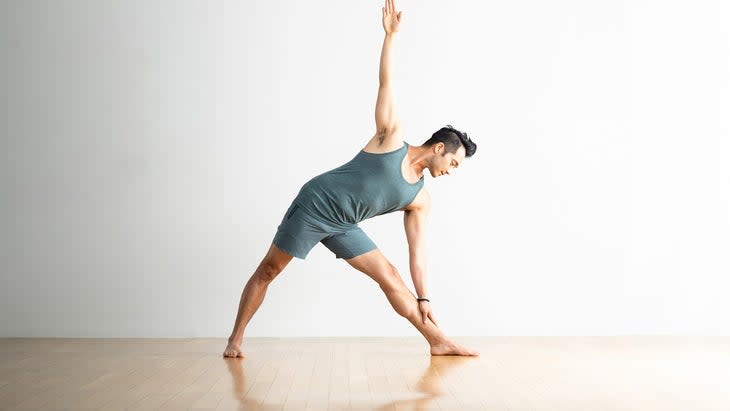
Utthita Trikonasana (Triangle Pose)
From Warrior II, straighten your right leg. On an exhalation, extend your torso to the right, reaching out toward your right leg as far as you are able. Then hinge at the hip and reach your right hand down toward the floor as you stretch your left arm toward the ceiling. Your hands, arms, and shoulders will form a straight line, perpendicular to your mat. Open your torso to the left, keeping both sides of the torso equally long. Open your chest, creating space and a heart-opening energetic movement in the pose while rolling shoulders back toward the spine. Stay in the pose for 3-5 breaths. To come up, reach up with your left arm and lift your torso to come back to standing in a wide-legged position.
Utthita Tadasana (Five-Pointed Star Pose)
Turn your right foot forward to come into Utthita Tadasana (Five-Pointed Star Pose). Continue to reach out strongly with both hands, and adjust your stance so that your feet are aligned with your hands. Relax your shoulders. Gently open your chest and breathe.
Utkata Konasana (Goddess Pose)
From you wide-legged stance, turn your toes out. Bend your knees and lower your torso straight down to bring your legs toward a 90-degree angle. Rotate your thighs externally and bring your knees wide to be in line with the direction of your feet. Keeping your shoulders open, bend your elbows 90-degrees to Trident or Cactus arms.
For a tutorial on this pose watch Master Goddess Pose with Sierra Campbell.
Repeat poses 1-7 on the other side. Then come to a seated position on your mat.
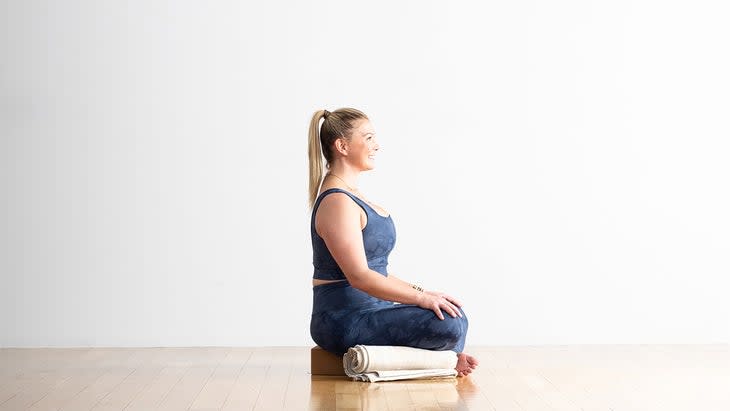
Sukhasana (Easy Pose)
To come into Easy Pose, sit on your mat, bend and open your knees, cross your shins, and pull your heels toward your torso. You can sit on a blanket, cushion or blocks; support your knees with rolled blankets. Adjust your posture so that your pelvis maintains a neutral position, without tilting forward or back, and lengthen your tail bone toward the floor. Firm your shoulder blades against your back to lengthen your upper torso. Don't over arch your lower back or poke your lower front ribs forward, but maintain an openness across your shoulders. Sit in this position for 3-5 breaths, then alternate the cross of the legs and take another 3-5 breaths. (To emphasize the feeling of chest opening in this pose, try sitting with your back to a wall, slightly closer than the length of a yoga block, and wedge the end of the block between the wall and your lower shoulder blades.)
Marjaryasana/Bitilasana (Cat/Cow Pose), seated
From Sukhasana, inhale, lengthen your spine and arch your back, creating a smooth, even curve from your tailbone up to the back of your head. Look up, but maintain length along the back of your neck. On an exhalation, round your spine, tucking your tailbone, drawing your belly in, and dropping your head toward your chest. Repeat the movements, slowly moving from Cat to Cow for several breaths, then return to Easy Pose.
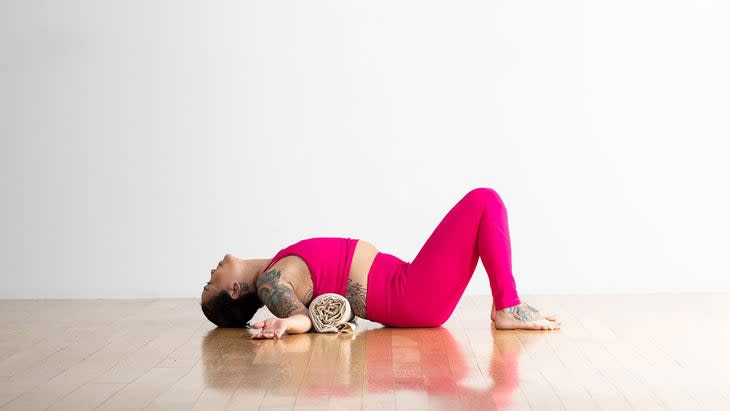
Matsyasana (Fish Pose)
For this variation of Fish Pose, roll a blanket and place it across your mat behind you. Lie back with your knees bent, feet on the floor. Adjust the blanket roll so that it is under your shoulder blades. Reach your arms out in a T-position. With an inhale, lift your head and release it back down so that the back of your head back rests on the floor. Stay for 3-5 breaths. To come out of the pose, roll to one side to remove the blanket then return to your reclined position.
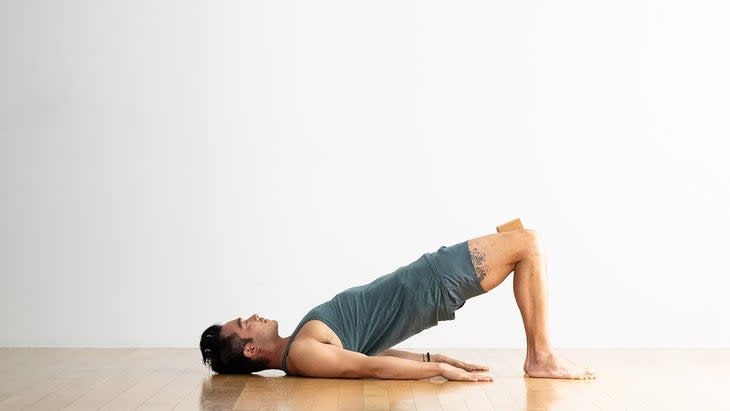
Setu Bandha Sarvangasana (Bridge Pose)
Lying on your back, come into Bridge Pose by bending your knees and bringing your feet to the floor, moving them as close to your buttocks as possible. Keep your legs, knees, and feet parallel and hip-distance apart. Press down firmly through both of your feet and your arms. On an inhalation, raise your hips. Broaden your collarbones and keep space between your chin and your chest. Hold for 3-5 breaths. On an exhalation, lower your hips to the floor. Allow your back to rest in a neutral state as you observe the spaciousness in your chest
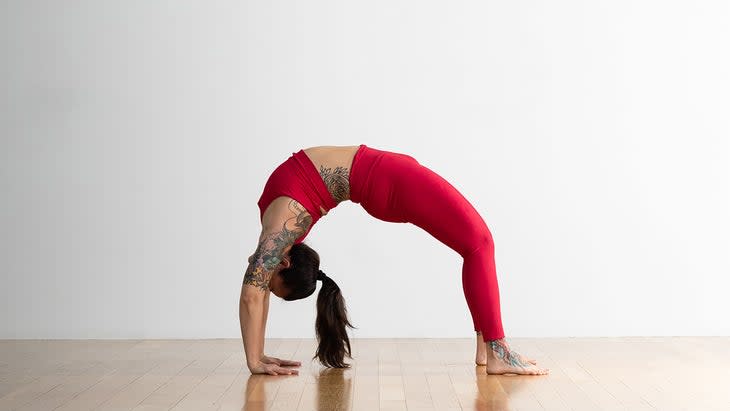
Urdhva Dhanurasana (Wheel Pose/Upward-Facing Bow Pose)
Come to Wheel Pose from Bridge. Lying down with your knees bent, check that your legs and feet are hip-distance apart and parallel. Place your feet directly under your knees. Reach back to place your hands alongside your ears with your palms down and your fingers pointing toward your shoulders. Draw your elbows toward one another, and start to arch your middle and upper back. On an exhalation, lift your hips, torso, and head enough to place the crown of your head on the mat, without resting any weight on your head. With the next inhalation, press down with your hands and feet, and lift into the pose. Stay in the pose for 1-2 breaths. To come out of the pose, tuck your chin and lower your body directly to the floor.
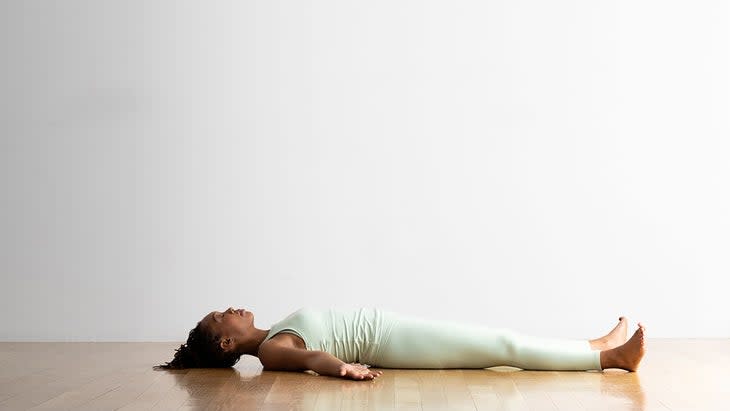
Savasana (Corpse Pose)
To end your sequence in a resting pose, slowly extend your legs with your feet apart and toes turned out equally. Rest your arms by your sides, angled evenly away from your body and extended toward your feet. Turn your palms up. Ease your shoulders down and away from your ears, and rest your shoulder blades evenly on the floor. Make whatever adjustments you need to find comfort in the pose, relaxing your body from your toes to your head. Soften your face and cast your eyes downward to gaze toward your heart. Stay in this pose for at least 5 minutes, breathing.
For exclusive access to all of our fitness, gear, adventure, and travel stories, plus discounts on trips, events, and gear, sign up for Outside+ today.

